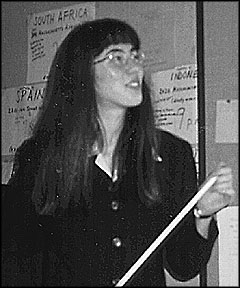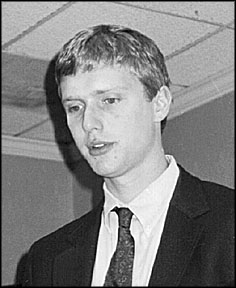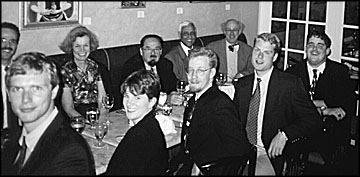  |
Lopatnikova graduated from MIT in 1997 and is being honored for her thesis entitled, "Renormalization-Group Theory of Superfluidity and Phase Separation of Helium Mixtures Immersed in Aerogel." Her work reproduced and explained several new experimental features, such as a phase separation between two superfluid phases, a critical point imbedded within superfluidity, and the occurrences of a superfluid phase with very low 4He concentrations. This resulted in the publication of one paper in Physical Review B, as well as a follow-up paper recently submitted, and has suggested new experimental directions. She has been awarded fellowships from both the NSF and Bell Laboratories to pursue graduate studies in physics.
Specifically, Lopatnikova's work on the renormalization group theory for helium-mixture phase transitions immersed in a disordered porous medium involved the coupled mappings of bulk and surface probability distributions of quenched disorder in the system, and the mastery of the random-field and random-bond problems of critical phenomena. She successfully completed this very difficult calculation that only a few full-time condensed matter physicists in the world can do, since it requires taking into account subtle physical effects, factorizing and then interlacing superfluidity and criticality with the connectivity, tenuousness and randomness properties of aerogel. Since then, she has obtained results in the question of the existence or non-existence of a gap in the excitation spectrum of quantum magnetic systems, with relevance to high-temperature superconductivity.
Geddes graduated from Swathmore College in 1997 with a degree in physics and high honors, the latter received in part because of his excellent thesis research in plasma physics, entitled, "Spheromak Equilibrium Studies on SSX." In fact, he was awarded the William C. Elmore Prize as the top physics graduate at the college. His thesis is based on some of the initial experiments performed on the Swarthmore Spheromak Experiment at the school's new Magnetofluids Laboratory.
The experiment's ultimate goal is to simulate conditions in solar flares (100,000 degrees C) for a very short time (100 millionths of a second) in order to study fundamental magnetofluid processes. Using techniques borrowed from magnetic confinement fusion, the team is able to generate a hot ring of magnetized plasma called a spheromak. Geddes characterized the magnetic structure of these spheromaks using arrays of magnetic probes of his own construction, and using his own analysis, fit the data to various models. He also made presentations of this work to members of the Swathmore Board of Trustees, and at the 1996 APS Division of Plasma Physics Meeting in Denver, Colorado.
 Committee members (rear, left to right): Steven Ralph (Emory), June Matthews (MIT), Harry Lustig (APS), Kumar Patel (UCLA), Barrie Ripin (APS) and Finalists (front, right to left): Scott Hill, David Ginger, Stuart Norton, Julie Hoff, and Cameron Geddes. Finalist Anna Lopatnikova and selection committee members Robert Schrieffer (Florida State) and Laurence Marshall (Gettysburg College) are missing from the photo. |
©1995 - 2024, AMERICAN PHYSICAL SOCIETY
APS encourages the redistribution of the materials included in this newspaper provided that attribution to the source is noted and the materials are not truncated or changed.
January 1998 (Volume 7, Number 1)
Articles in this Issue

